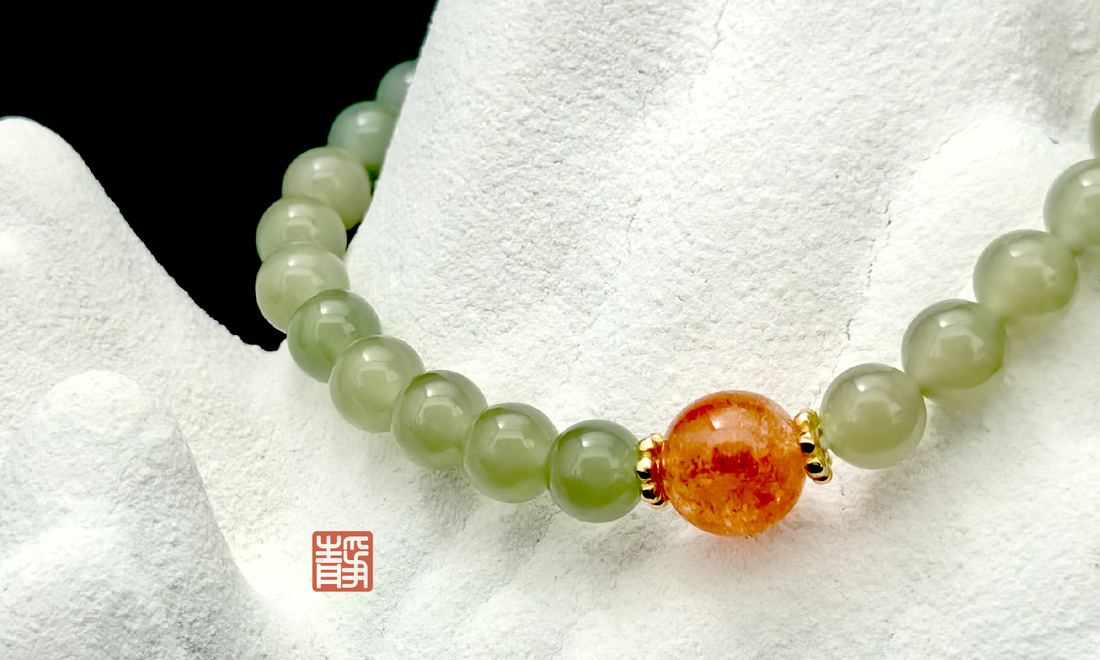
Common Crystal Imperfections
JING_FFShare
At JING Balance, we only use natural, untreated crystals —never dyed, irradiated, or lab-enhanced. Because of this commitment, each piece may carry unique textures, inclusions, or variations that tell a story of its geological journey.
These are not imperfections to be feared.
They are signs of authenticity —proof that your crystal came directly from nature, untouched and full of original energy.
Below, we introduce some of the most common natural features you may see in your crystal bracelet, along with what they mean.
Table of content
Common Natural Features in Crystals
1. Rutile Roots
These are dark root-like points at the base of rutile threads (often in golden or black rutile quartz). They mark where the needle-like inclusions began to grow, usually composed of rutile and mica .
A sign of deep inner strength and structural formation.

2. Mineral Cavities
Small pits or dents on the surface, formed when other minerals once grew with the crystal and later fell off during polishing , leaving natural voids behind.
A glimpse into the crystal's layered history and evolution.

3. Feathering or Secondary Cracks
Tiny cracks caused by tectonic movements or pressure during the crystal’s formation. Some have been partially sealed by later hydrothermal fluids.
A natural response to Earth’s transformation—just like emotional scars that heal.

4. Ice Cracks
Internal fissures resembling icy textures, especially common in rose quartz, amethyst, and clear quartz . These form due to temperature shifts and pressure changes over time.
A beautiful reminder that resilience can be found in even the most delicate forms.

5. Mineral Companions
Other minerals growing together with the main crystal, due to shared geological conditions. Seen as patches or veins of color or texture.
Symbolic of coexistence and mutual support—just like people in your life.

6. Color Zoning
Natural bands or layers of color formed as the crystal grew under changing environmental conditions. Often seen in fluorite, ametrine, or smoky quartz.
A visual timeline of transformation, showing depth and complexity.

7. Black Spots
Rounded dark inclusions from mineral deposits during growth. Harmless and usually found in quartz varieties.
Earth’s fingerprint, captured in crystal form.

8. Mica Flakes
Larger flat inclusions that reflect light—formed when mica crystals were enveloped during the crystal’s development.
Reminders of hidden brilliance within.

9. Mineral Inclusions
Trapped pieces of other minerals inside the crystal body—such as chlorite, hematite, or lepidocrocite—formed from geological shifts during growth.
A mark of nature’s layered energy field, captured in stone.

10. Cotton-like or Misty Veins
Soft, foggy, or cottony patterns within transparent crystals. Common in golden rutilated quartz, titanium quartz, or amethyst.
Symbolic of inner softness, introspection, and emotional processing.

11. Flat Head or “Pancake” Beads
Flat spots where larger inclusions were polished away , resulting in a slightly flattened surface. Often seen in round beads that were shaped from raw crystals.
Natural transformation through refinement.

12. Drill Chips
Tiny nicks near the bead hole—formed when brittle crystals are drilled during stringing. These do not affect energy or durability.
Part of the craftsmanship behind turning raw crystals into wearable energy.

Why We Embrace These Natural Features?
Every one of these markings is a reminder that perfection is not the goal—authenticity is.
Wearing a crystal with natural imperfections allows you to connect more deeply with the Earth and yourself. Each “flaw” is a signature of origin , not a defect.
At JING Balance, we believe in honoring nature's raw beauty.
That's why we never cover up these natural details—they make your piece truly one of a kind .
If you have any questions about your bracelet or a specific crystal feature, feel free to contact us. We’re always here to help you understand the story your stone carries.
